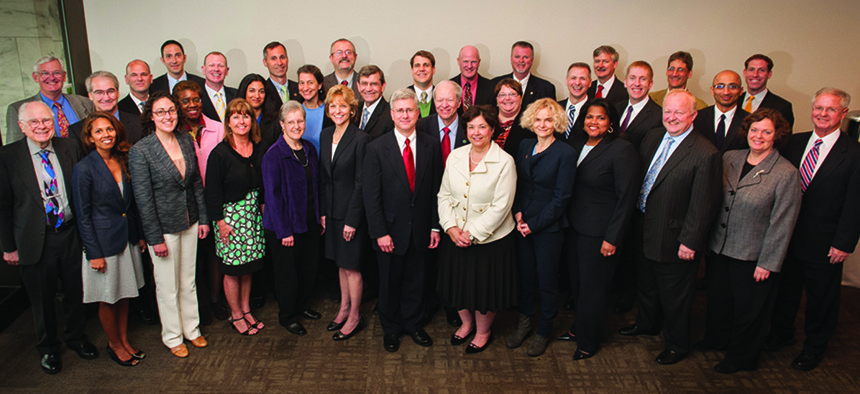
The 2013 Service to America finalists. Sam Kittner/Kittner.com
Service To America Medal Finalists Exemplify Management Excellence
The 2013 Sammies finalists have been announced.
Federal managers play a crucial role in the effective operation of government, but their hard work, smart business practices and innovations often go unrecognized.
On Oct. 3, the Partnership for Public Service will present the prestigious Samuel J. Heyman Service to America Medal for Management Excellence to one of the four finalists profiled below, individuals whose accomplishments include reforming the nation’s patent office, bringing energy efficiency to the Air Force, revitalizing a Small Business Administration investment program and consolidating IT operations of federal agencies operating overseas.
These public servants are among 31 finalists honored in seven medal categories ranging from justice and law enforcement to science and environment. Here are the stories of the Service to America Medal finalists in the Management Excellence category:
Margaret Focarino: Revamped the government’s patent review system
In 2009, the United States Patent and Trademark Office (USPTO) was in a state of crisis. The backlog of pending patent applications was enormous and growing. The process for reviewing patents had not changed in decades and was out-of-date. Employee job satisfaction was low and the longstanding distrust between management and the patent examiners union was ever-present.
In the last several years, all of that changed dramatically with a series of bold reforms and new business practices that were implemented by a team led by Margaret (Peggy) Focarino, then the deputy and now the commissioner for patents.
Working with labor and the backing of agency leadership, Focarino negotiated and implemented the first significant changes to the patent examiner work processes in 30 years, which included giving examiners more time and flexibility to handle cases. As a result, the USPTO lowered the backlog of unexamined patent applications even as submissions increased; shortened the amount of time it takes to process applications; and improved the quality of the examinations.
“The agency is doing higher-quality work and more work per person than ever before, and that can be attributed to Peggy Focarino’s leadership,” said Dave Kappos, who served as under secretary of commerce for intellectual property and director of the USPTO from 2009 to early 2013. “She knew how to engineer huge change, get people to enthusiastically follow and make the changes stick.”
Kevin T. Geiss: Bringing energy efficiency to the Air Force
In 2010, the U.S. Air Force adopted the motto "Aim High...Fly-Fight-Win," a fitting phrase that embodies the service’s enduring commitment to excellence in the air defense of our nation.
Kevin Geiss, the Air Force’s deputy assistant secretary for energy, is likewise committed, but to an even more expansive mission. His goal is to see America’s airmen fly, fight and win in an environment that has reliable sources of energy and that places a new emphasis on conservation, alternative fuels and reducing costs.
To reach these goals, Geiss stood up an Air Force energy office, crafted a strategic plan, began preaching a new way of thinking throughout the service and boldly implemented a series of highly successful energy reforms. These changes have saved more than $1 billion by reducing fuel use by millions of gallons, and resulted in conservation initiatives that have lowered installation utility costs. The Air Force is the largest single consumer of energy in the federal government, spending more than $9 billion on fuel and electricity in fiscal 2012.
“Kevin has the big picture in mind,” said Ben Steinberg of the White House Council on Environmental Quality. “He has gotten the Air Force to begin thinking about the importance of energy to its operations and how by maximizing energy use, it can better accomplish its mission at lower cost.”
Harry Haskins: Revitalized SBA program, spurring new investments and job creation
As the U.S. economy was sinking into recession in 2008, a Small Business Administration (SBA) program designed to provide investment capital to private equity firms was stagnant and ill-prepared to help stimulate economic growth.
Thanks to Harry Haskins, the former deputy associate administrator of the SBA’s Investment Division, this state of affairs began to change in 2009. Haskins led his team to institute a series of reforms that included streamlining and simplifying the licensing processes to more quickly make private investment firms eligible for funding. At the same time, commercial financial institutions had stopped lending as the economic crisis worsened, making the guaranteed loans from government’s Small Business Investment Company (SBIC) program more attractive.
Haskins and his staff cut average processing times to license new investment firms from just under 15 months in 2009 to just over five months in 2012, and they committed $1.9 billion in funds to the private equity firms during 2012 alone compared to $788 million in 2009. These investments led to the creation or retention of an estimated 63,000 jobs in 2012 compared to about 28,000 three years earlier.
“Harry and his team were vital in transforming the SBIC into a model public-private partnership and elevated it to meet the desperate need of the economy for capital,” said SBA Administrator Karen Mills.
Claire Votaw: Consolidating IT operations for federal agencies operating overseas
There are some 40 federal agencies with offices in foreign countries that traditionally have maintained their own Internet, email, and computer systems and that have paid separately for support services and security, resulting in extra costs and needless duplication.
Claire Votaw, the director of the State Department’s Project Services Office, is heading an ambitious effort to consolidate many of these redundant operations by providing shared IT services to American embassies and agencies that operate alongside the diplomatic corps.
The Foreign Affairs Network (FAN) offers a cost-effective alternative for federal agencies to access and share the State Department managed IT infrastructure. The network eliminates the need to maintain separate systems overseas, creates greater economies of scale, and enables collaboration, information sharing and enhanced security.
Blair Townsend, a division chief of the State Department’s Project Services Office, said eliminating IT redundancies has huge implications not only for cost and efficiency, but for safety.
“Claire was able to successfully create this new alternative from the ground up amid highly held traditions,” said Janice Fedak, a State department deputy chief information officer.
Lara Shane is Vice President of Research and Communications at the nonprofit Partnership for Public Service. This article is the first in a series on the Samuel J. Heyman Service to America Medal (Sammies) finalists. For information about the awards and how to nominate a federal employee for a medal, go to servicetoamericamedals.org. The 2013 Sammies program is supported by national sponsors Booz Allen Hamilton, Boston Consulting Group, Chevron, ConantLeadership and United Technologies Corporation.







